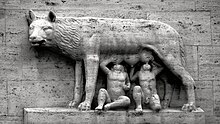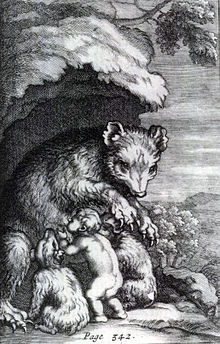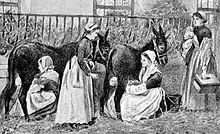Human-animal breastfeeding
The human-animal breastfeeding was practiced in different cultures at different times. The practice of breastfeeding or lactation between humans and other species gave it both ways; Just as women nursed young animals, animals were used to nurse human babies and children. The animals were used as wet nurse substitutes for infants, especially after the increase in syphilis increased the health risk, as breastfeeding could transmit the disease. In Europe, goats and donkeys were often used in foundling homes in the 18th and 19th centuries to feed the abandoned children. Animals, in turn, were breastfed by women for health reasons - for example, to harden the nipples and improve the flow of milk - or for religious and cultural purposes. Puppies, kittens, piglets, and monkeys, among others, have been used for this purpose.
Suckling of humans by animals
Terracotta baby bottles from the third millennium BC B.C., which were found in Sumer , are considered an indication that children who were not breastfed at the time were given animal milk, presumably that of cows. It is possible that some children were suckled directly by lactating animals, an alternative to nursing by nurses. Unless other breastfeeding women were available, a mother who did not have enough breast milk was likely to lose her baby. To prevent this, animals such as donkeys, cows, goats, sheep or dogs were used. Direct suckling was preferable to milking because milking could lead to contamination by microbes. This often led to fatal diarrhea. A risk that existed until the 1870s; thereafter the risk of infection from stored animal milk decreased with the invention of pasteurization and sterilization.
Stories and legends
The suckling of human infants by animals is a recurring theme in classical mythology. The best known is the legend of the legendary founders of Rome - the twins Romulus and Remus - who are said to have been suckled by a she-wolf as children; portrayed with the Capitoline She-Wolf , a life-size bronze figure of a she-wolf suckling Romulus and Remus. The Greek god Zeus is said to have been raised by the nymph Amaltheia with the milk of a goat; This has been portrayed on various occasions: once the god is suckled by a goat or the nymph brought him the goats' milk. Also Telephus , son of Hercules is said to have been suckled by a deer. Several famous ancient historical figures are said to have been suckled by animals: Cyrus I is said to have been suckled by a dog, while mares allegedly suckled Croesus , Xerxes, and Lysimachus . In reality, however, such stories are more likely to belong in the myth-making about such personalities, insofar as they were used as evidence of their future greatness.
Stories of abandoned children raised by animal mothers such as female wolves and bears were widespread in Europe from the Middle Ages to modern times. A real case was that of the wild Peter von Hameln , who was found in northern Germany in 1724. His thick, curly hair was attributed to the (supposed) fact that he was suckled by a she-bear, based on the premise that characteristics of the animal foster mother were passed on to him through her milk. According to more recent studies, however, it is said to have been the Pitt-Hopkins syndrome , a rare disease that was first described in 1978.
Effect on character
The belief that animal properties could be transmitted through milk was widespread. The Swedish scientist Carl von Linné assumed that those suckling lionesses were given great courage as a result. Goats were believed to transmit a libidinal character and there was some preference for using donkeys as wet nurses instead, as these were believed to be more moral animals. In modern Egypt, on the other hand, donkeys were discriminated against as wet nurses because it was assumed that a child suckled with donkey milk would acquire the animal's stupidity and stubbornness.
The teachings of the Qur'an discourage giving babies animal milk based on the assumption that it could transmit animal traits, while the Talmud allows children to be suckled by animals if the child's best interests so require. There was also the assumption that breast milk transmits these character traits. In 19th century France, there was a legislative proposal to forbid immoral mothers from caring for their own children, so that the immoral traits could not be transmitted through the milk.
Use of goats
Goats have been widely used to nurse human infants and young children. The Khoikhoi in southern Africa have been reported to tie their babies to the bellies of female goats so that they could feed them. In the 18th and 19th centuries, the use of goats as an alternative to human wet nurses was widespread in Europe because they were easier to obtain and cheaper than wet nurses, and they were considered safer as the goats were less likely to be in the Unlike human wet nurses, they transmitted diseases. This was a well established practice in the rural areas of France and Italy; Pierre Brouzet, the personal physician of Louis XV. von France described how he had seen some farmers "who had no other wet nurses except ewes, and these farmers were as strong and vigorous as the others." In 1816, the German writer Conrad A. Zwierlein overheard a conversation about the problems of Wet nurses and responded by publishing a book entitled "The goat as the best and cheapest suckling mammal" and thus popularized the use of these animals for many years.
A major reason for using goats to nurse babies was to try to cure infants with congenital syphilis who had inherited the disease from their mothers. The goats were fed a liquid compound of mercury - if they refused to drink it, honey was recommended as a way of disguising the metallic taste - or the mercury was absorbed into the goats' bloodstream through a deliberate wound on the animal's leg which was covered with an ointment containing mercury. It was assumed that the mercury would accumulate in the goats and be passed on to the syphilitic babies via the milk if they were suckled on the teats of these goats. This method has some effect on the improvement of mortality rates of infants, although the goats by prematurely died of mercury poisoning.
A large number of goats were kept in France's homes for foundlings; they were considered to be less of a problem than the lower-class women who otherwise came to breastfeed the infants. In some institutions the nurses brought the babies to the goats, in other places the goats came to the children. Alphonse Le Roy described how goats were used in the foundling house in Aix in 1775: “The cribs are arranged in two rows in a large room. Every goat that came to suckle came in grumbling and found the baby that was entrusted to it, removed the cover with its horns, and stretched itself over the crib to suckle the baby. Since then, they have raised very large numbers [infants] in this home. "
In nineteenth-century Ireland in Dublin, boulders were "sent to the Wicklow Mountains to feed on goat's milk ... these children thrived remarkably well." In England donkeys were preferred and, as one writer put it, "was nothing." more picturesque than the spectacle of babies being kept under the donkey's bellies in the stable [...] they suck happily on the teats of docile donkeys. ”In Brittany around 1900 attempts were made to employ sows as wet nurses, but it failed the pigs' resistance to using them for this purpose.
Breastfeeding animals by humans
The breastfeeding of animals by humans is a practice that has been historically attested and is still practiced today by some cultures. There are many reasons for this practice: young animals are suckled to empty a woman's breasts, to stimulate lactation , to develop good nipples, to prevent conception, etc. An example of this practice comes from England: As the writer Mary Wollstonecraft in 1797 by following the birth of her second daughter puerperal fever was dying, the doctor ordered that puppies were placed on her breasts to the milk deduct, possibly with the intention of thereby their uterus to such contract that the infected placenta that she slowly poisoned, was repelled. Similarly, between the 16th and 18th centuries, English and German doctors recommended “pulling off” milk from the mother's breasts with puppies. In 1799, the German obstetrician Friedrich Benjamin Osiander reported that women in Göttingen suckled young dogs in order to remove the nodules from their breasts.
There are also religious and ceremonial reasons for breastfeeding animals: Saint Veronica Giuliani (1660–1727), an Italian nun and mystic, was known to have a lamb in bed and suckle it, symbolizing the famous lamb God . The Japanese Ainu sacrifice a bear for an annual bear festival, which has previously been captured, raised and breastfed by the women. The Itelmen on the Kamchatka Peninsula in Russia also suckled bears; in their case, for economic reasons, to benefit from the meat and obtain the highly priced bear bile used in traditional Chinese medicine .
Animals were also commonly used as “milk siblings” for toddlers to harden the nipples and maintain lactation. In Persia and Turkey, puppies were used for this purpose. This was also practiced in the United States in the early 19th century; The doctor William Potts Dewees recommended in 1825 that from the eighth month of pregnancy, expectant mothers regularly hardened their nipples with a puppy, improved the secretion of their breasts and thus prevented breast inflammation . The practice appears to have fallen out of favor around 1847 when Dewees suggested that a nurse or other professional would be more suited to the job than an animal. Indigenous peoples around the world have used many types of animals for the same purpose. Travelers in Guyana observed local women breastfeeding a variety of animals, including monkeys, possums , pakas , agoutis , wild boars, and deer. The Aborigines of Canada and America often breastfed puppies; one observer noted that the Pima , a North American Indian tribe, "were more likely to pull their breasts away from their own children than from young dogs."
In the present, the act of breastfeeding animals has also been used for controversial artistic statements: the album cover for Boys for Pele by Tori Amos shows a photo of the singer breastfeeding a piglet. In Ireland, 22-year-old model and PETA member Agata Dembiecka became the center of controversy in 2010 when she was shown in a photo on an animal welfare organization calendar breastfeeding a puppy.
literature
- Samuel X. Radbill: The Role of Animals in Infant Feeding . In: Wayland D. Hand (Ed.): American Folk Medicine: A Symposium . University of California Press, 1976, ISBN 9780520040939 .
- C. Savona-Ventura: Breast versus Bottle. A history of Infant feeding in Malta . Association for the Study of Maltese Medical History, 2004, ISBN 99932-663-1-0 .
- Deborah Valenze: Milk: A Local and Global History . Yale University Press, 2011, ISBN 9780300117240 .
- Penny Van Esterik: The Politics of Breastfeeding . In: Patricia Stuart-Macadam, Katherine A. Dettwyler (Eds.): Breastfeeding: Biocultural Perspectives . Aldine, 1995, ISBN 9780202011929 .
- Londa L. Schiebinger: Nature's Body: Gender In The Making Of Modern Science . Rutgers University Press, 1993, ISBN 9780813535319 .
Individual evidence
- ↑ Penny Van Esterik: The Politics of Breastfeeding . In: Patricia Stuart-Macadam, Katherine A. Dettwyler (Eds.): Breastfeeding: Biocultural Perspectives . 1995, p. 147.
- ↑ Audrey H. Ensminger: Concise Encyclopedia of Foods and Nutrition . CRC Press, 1995, ISBN 9780849344558 , p. 572.
- ↑ C. Savona-Ventura: Breast versus Bottle. A history of Infant feeding in Malta . 2004, p. 16.
- ^ A b c Samuel X. Radbill: The Role of Animals in Infant Feeding . In: Wayland D. Hand (Ed.): American Folk Medicine: A Symposium . 1976, p. 22.
- ↑ a b c C. Savona-Ventura: Breast versus Bottle. A history of Infant feeding in Malta . 2004, p. 56.
- ↑ Maev Kennedy: Peter the Wild Boy's condition revealed 200 years after his death . In: The Guardian , March 20, 2011.
- ^ A b c d Samuel X. Radbill: The Role of Animals in Infant Feeding . In: Wayland D. Hand (Ed.): American Folk Medicine: A Symposium . 1976, p. 24.
- ↑ Omm Sety: Omm Sety's Living Egypt: Surviving Folkways from Pharaonic Times . Glyphdoctors, 2008, ISBN 9780979202308 , p. 2.
- ^ Samuel X. Radbill: The Role of Animals in Infant Feeding . In: Wayland D. Hand (Ed.): American Folk Medicine: A Symposium . 1976, p. 23.
- ↑ a b Deborah Valenze: Milk: A Local and Global History . 2011, p. 159.
- ↑ June K. Burton: Napoleon and the Woman Question . Texas Tech University Press, 2007, ISBN 9780896725591 , pp. 108-109.
- ^ Charles Henry F. Routh: Infant feeding and its influence on life: or, The causes and prevention of infant mortality . John Churchill, 1860, p. 156.
- ^ Samuel X. Radbill: The Role of Animals in Infant Feeding . In: Wayland D. Hand (Ed.): American Folk Medicine: A Symposium . 1976, p. 25.
- ^ A b c d Samuel X. Radbill: The Role of Animals in Infant Feeding . In: Wayland D. Hand (Ed.): American Folk Medicine: A Symposium . 1976, p. 26.
- ^ Claire Tomalin: The Life and Death of Mary Wollstonecraft . Penguin UK, 2004, ISBN 9780141912264 , pp. 280-281.
- ^ Samuel X. Radbill: The Role of Animals in Infant Feeding . In: Wayland D. Hand (Ed.): American Folk Medicine: A Symposium . 1976, pp. 2-7.
- ^ Samuel X. Radbill: The Role of Animals in Infant Feeding . In: Wayland D. Hand (Ed.): American Folk Medicine: A Symposium . 1976, p. 27.
- ↑ Picture of the album cover by Tori Amos
- ↑ Christopher John Farley: Tori, Tori, Tori! . In: TIME , May 11, 1998.
- ↑ Mucky pups: Outrage over racy images of scantily-clad women in bizarre poses with dogs for charity calendar . In: Daily Mail , December 30, 2010.



